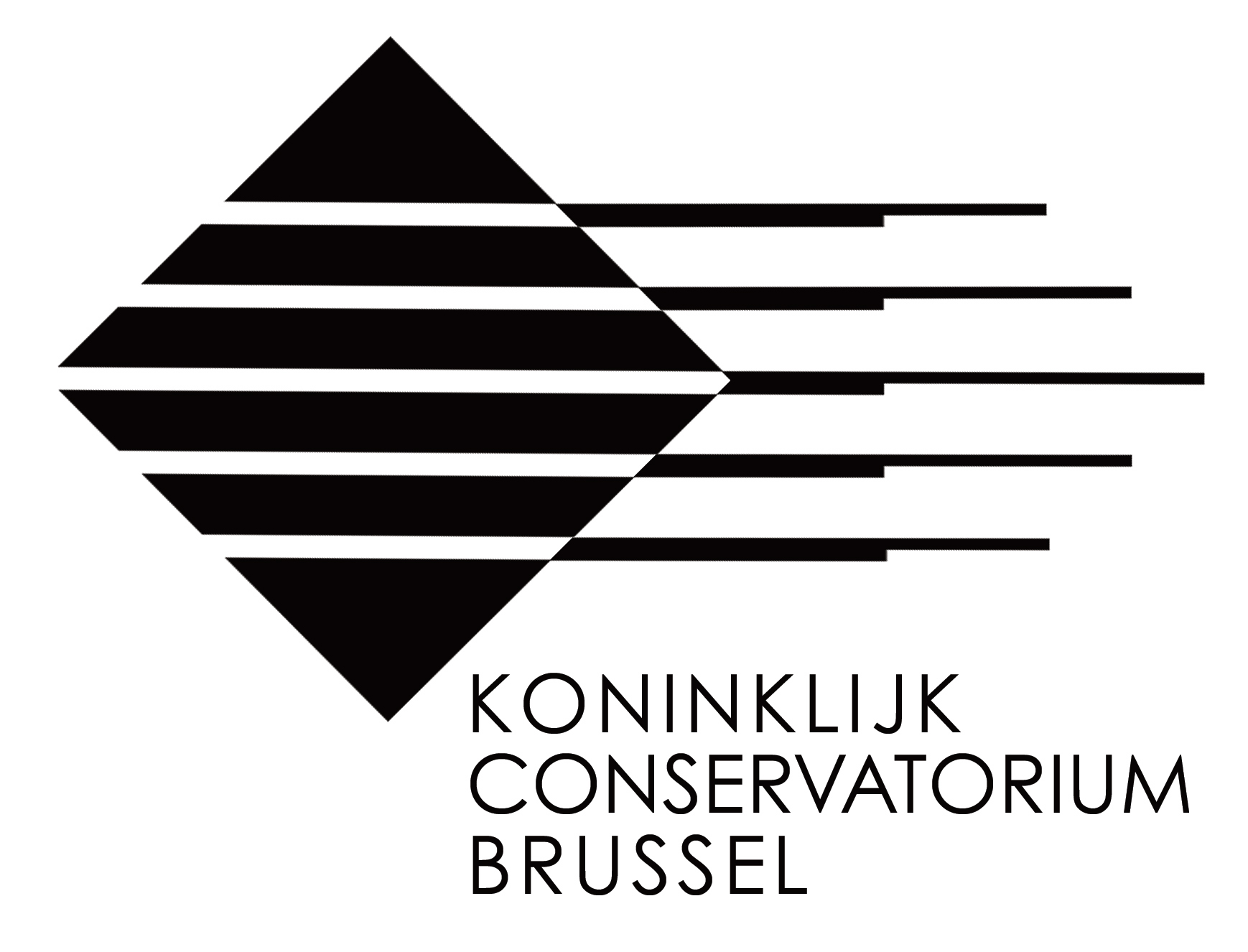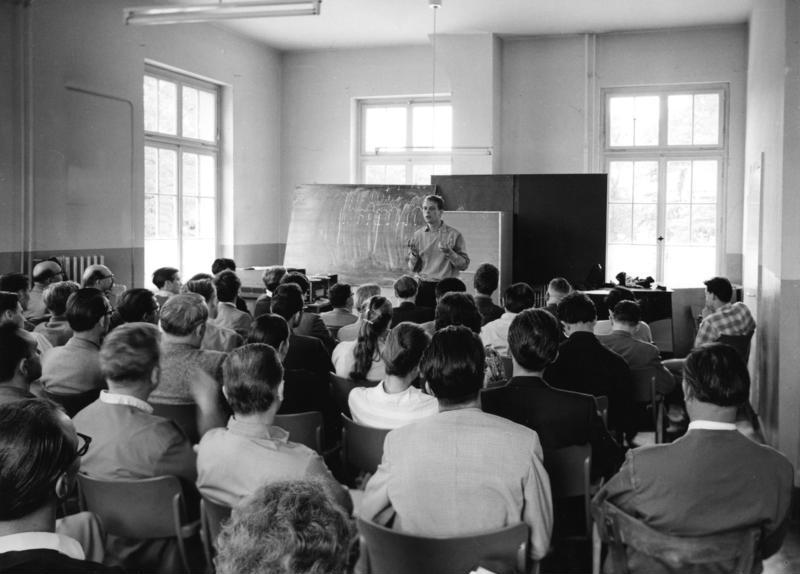|
André Laporte
André Laporte (born 12 July 1931) is a Belgian composer. Biography Laporte was born in Oplinter, near Tienen in Flemish Brabant. He studied music with Edgard de Laet, Flor Peeters, and Marinus De Jong at the Lemmens Institute in Mechelen, and musicology and philosophy at the Catholic University of Leuven from 1953 to 1957. From 1960 to 1964 he participated annually in the Internationale Ferienkurse für Neue Musik in Darmstadt, where he came into contact with Pierre Boulez, Bruno Maderna, Luciano Berio, György Ligeti, and Mauricio Kagel, amongst others.( In addition, he attended the Second and Third Cologne Courses for New Music organized by Karlheinz Stockhausen, in 1964–65 and 1965–66 where, in addition to Stockhausen, he had the opportunity of meeting the composers Henri Pousseur and Luciano Berio, as well as the conductor Michael Gielen. Starting in 1953, Laporte taught music at a secondary school in Brussels. In 1963 he helped to establish the SPECTRA work group at the ... [...More Info...] [...Related Items...] OR: [Wikipedia] [Google] [Baidu] |
Tienen
Tienen (; french: Tirlemont ) is a city and municipality in the province of Flemish Brabant, in Flanders, Belgium. The municipality comprises Tienen itself and the towns of Bost, Goetsenhoven, Hakendover, Kumtich, Oorbeek, Oplinter, Sint-Margriete-Houtem and Vissenaken. On 1 January 2017, Tienen had a total population of 34,365. The total area is which gives a population density of . History In the early Middle Ages, the town was probably ruled by an old German family Thienen. During the 1635 to 1659 Franco-Spanish War, Tienen was part of the Spanish Netherlands and was captured by a combined Franco-Dutch army in May 1635. Its capture resulted in one of the most serious atrocities of the Dutch Revolt; the town was sacked, over 200 civilians killed and many buildings damaged, including Catholic churches and monasteries. This ended Dutch prospects of winning over the predominantly Catholic population of the Southern Netherlands. After the 1714 Treaty of Utrecht, the town ... [...More Info...] [...Related Items...] OR: [Wikipedia] [Google] [Baidu] |
Royal Conservatory Of Brussels
The Royal Conservatory of Brussels (french: Conservatoire royal de Bruxelles, nl, Koninklijk Conservatorium Brussel) is a historic conservatory in Brussels, Belgium. Starting its activities in 1813, it received its official name in 1832. Providing performing music and drama courses, the institution became renowned partly because of the international reputation of its successive directors such as François-Joseph Fétis, François-Auguste Gevaert, Edgar Tinel, Joseph Jongen or Marcel Poot, but more because it has been attended by many of the top musicians, actors and artists in Belgium such as Arthur Grumiaux, José van Dam, José Van Dam, Sigiswald Kuijken, Josse De Pauw, Luk van Mello and Luk De Konink. Adolphe Sax, inventor of the saxophone, also studied at the Brussels Conservatory. In 1967, the institution split into two separate entities: the , which teaches in Dutch language, Dutch, and the , which continued teaching in French language, French. While the French-speaking en ... [...More Info...] [...Related Items...] OR: [Wikipedia] [Google] [Baidu] |
Opera
Opera is a form of theatre in which music is a fundamental component and dramatic roles are taken by singers. Such a "work" (the literal translation of the Italian word "opera") is typically a collaboration between a composer and a librettist and incorporates a number of the performing arts, such as acting, scenery, costume, and sometimes dance or ballet. The performance is typically given in an opera house, accompanied by an orchestra or smaller musical ensemble, which since the early 19th century has been led by a conductor. Although musical theatre is closely related to opera, the two are considered to be distinct from one another. Opera is a key part of the Western classical music tradition. Originally understood as an entirely sung piece, in contrast to a play with songs, opera has come to include numerous genres, including some that include spoken dialogue such as '' Singspiel'' and '' Opéra comique''. In traditional number opera, singers employ two styles of ... [...More Info...] [...Related Items...] OR: [Wikipedia] [Google] [Baidu] |
Twelve-tone Technique
The twelve-tone technique—also known as dodecaphony, twelve-tone serialism, and (in British usage) twelve-note composition—is a method of musical composition first devised by Austrian composer Josef Matthias Hauer, who published his "law of the twelve tones" in 1919. In 1923, Arnold Schoenberg (1874–1951) developed his own, better-known version of 12-tone technique, which became associated with the "Second Viennese School" composers, who were the primary users of the technique in the first decades of its existence. The technique is a means of ensuring that all 12 notes of the chromatic scale are sounded as often as one another in a piece of music while preventing the emphasis of any one notePerle 1977, 2. through the use of tone rows, orderings of the 12 pitch classes. All 12 notes are thus given more or less equal importance, and the music avoids being in a key. Over time, the technique increased greatly in popularity and eventually became widely influential on 20th-cent ... [...More Info...] [...Related Items...] OR: [Wikipedia] [Google] [Baidu] |
Microtonal Music
Microtonal music or microtonality is the use in music of microtones—intervals smaller than a semitone, also called "microintervals". It may also be extended to include any music using intervals not found in the customary Western tuning of twelve equal intervals per octave. In other words, a microtone may be thought of as a note that falls between the keys of a piano tuned in equal temperament. In ''Revising the musical equal temperament,'' Haye Hinrichsen defines equal temperament as “the frequency ratios of all intervals are invariant under transposition (translational shifts along the keyboard), i.e., to be constant. The standard twelve-tone ''equal temperament'' (ET), which was originally invented in ancient China and rediscovered in Europe in the 16th century, is determined by two additional conditions. Firstly the octave is divided into twelve semitones. Secondly the octave, the most fundamental of all intervals, is postulated to be pure (beatless), as described by the ... [...More Info...] [...Related Items...] OR: [Wikipedia] [Google] [Baidu] |
Triad (music)
In music, a triad is a set of three notes (or "pitch classes") that can be stacked vertically in thirds.Ronald Pen, ''Introduction to Music'' (New York: McGraw-Hill, 1992): 81. . "A triad is a set of notes consisting of three notes built on successive intervals of a third. A triad can be constructed upon any note by adding alternating notes drawn from the scale.... In each case the note that forms the foundation pitch is called the ''root'', the middle tone of the triad is designated the ''third'' (because it is separated by the interval of a third from the root), and the top tone is referred to as the ''fifth'' (because it is a fifth away from the root)." Triads are the most common chords in Western music. When stacked in thirds, notes produce triads. The triad's members, from lowest-pitched tone to highest, are called: * the root **Note: Inversion does not change the root. (The third or fifth can be the lowest note.) * the third – its interval above the root being a minor thi ... [...More Info...] [...Related Items...] OR: [Wikipedia] [Google] [Baidu] |
Eclecticism
Eclecticism is a conceptual approach that does not hold rigidly to a single paradigm or set of assumptions, but instead draws upon multiple theories, styles, or ideas to gain complementary insights into a subject, or applies different theories in particular cases. However, this is often without conventions or rules dictating how or which theories were combined. It can sometimes seem inelegant or lacking in simplicity, and eclectics are sometimes criticized for lack of consistency in their thinking. It is, however, common in many fields of study. For example, most psychologists accept certain aspects of behaviorism, but do not attempt to use the theory to explain all aspects of human behavior. Eclecticism in ethics, philosophy, politics and religion is also known as syncretism. Origin Eclecticism was first recorded to have been practiced by a group of ancient Greek and Roman philosophers who attached themselves to no real system, but selected from existing philosophical beliefs t ... [...More Info...] [...Related Items...] OR: [Wikipedia] [Google] [Baidu] |
Avant-garde
The avant-garde (; In 'advance guard' or ' vanguard', literally 'fore-guard') is a person or work that is experimental, radical, or unorthodox with respect to art, culture, or society.John Picchione, The New Avant-garde in Italy: Theoretical Debate and Poetic Practices' (Toronto: University of Toronto Press, 2004), p. 64 . It is frequently characterized by aesthetic innovation and initial unacceptability.Kostelanetz, Richard, ''A Dictionary of the Avant-Gardes'', Routledge, May 13, 2013 The avant-garde pushes the boundaries of what is accepted as the norm or the '' [...More Info...] [...Related Items...] OR: [Wikipedia] [Google] [Baidu] |
Darmstadt School
Darmstadt School refers to a group of composers who were associated with the Darmstadt International Summer Courses for New Music (Darmstädter Ferienkurse) from the early 1950s to the early 1960s in Darmstadt, Germany, and who shared some aesthetic attitudes. Initially, this included only Pierre Boulez, Bruno Maderna, Luigi Nono, and Karlheinz Stockhausen, but others came to be added, in various ways. The term does not refer to an educational institution. Initiated in 1946 by Wolfgang Steinecke, the Darmstädter Ferienkurse, held annually until 1970 and subsequently every two years, encompass the teaching of both composition and interpretation and also include premières of new works. After Steinecke's death in 1961, the courses were run by (1962–81), Friedrich Ferdinand Hommel (1981–94), Solf Schaefer (1995–2009), and Thomas Schäfer (2009– ). Thanks to these courses, Darmstadt is now a major centre of modern music, particularly for German composers, and has been ref ... [...More Info...] [...Related Items...] OR: [Wikipedia] [Google] [Baidu] |
Neoclassicism (music)
Neoclassicism in music was a twentieth-century trend, particularly current in the interwar period, in which composers sought to return to aesthetic precepts associated with the broadly defined concept of "classicism", namely order, balance, clarity, economy, and emotional restraint. As such, neoclassicism was a reaction against the unrestrained emotionalism and perceived formlessness of late Romanticism, as well as a "call to order" after the experimental ferment of the first two decades of the twentieth century. The neoclassical impulse found its expression in such features as the use of pared-down performing forces, an emphasis on rhythm and on contrapuntal texture, an updated or expanded tonal harmony, and a concentration on absolute music as opposed to Romantic program music. In form and thematic technique, neoclassical music often drew inspiration from music of the 18th century, though the inspiring canon belonged as frequently to the Baroque and even earlier periods as t ... [...More Info...] [...Related Items...] OR: [Wikipedia] [Google] [Baidu] |
Piano Sonata
A piano sonata is a sonata written for a solo piano. Piano sonatas are usually written in three or four movements, although some piano sonatas have been written with a single movement ( Scarlatti, Liszt, Scriabin, Medtner, Berg), others with two movements (Haydn, Beethoven), some contain five (Brahms' Third Piano Sonata) or even more movements. The first movement is generally composed in sonata form. The Baroque keyboard sonata In the Baroque era, the use of the term "sonata" generally referred to either the sonata da chiesa (church sonata) or sonata da camera (chamber sonata), both of which were sonatas for various instruments (usually one or more violins plus basso continuo). The keyboard sonata was relatively neglected by most composers. The sonatas of Domenico Scarlatti (of which there are over 500) were the hallmark of the Baroque keyboard sonata, though they were, for the most part, unpublished during Scarlatti's lifetime. The majority of these sonatas are in one-m ... [...More Info...] [...Related Items...] OR: [Wikipedia] [Google] [Baidu] |








